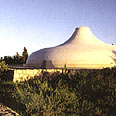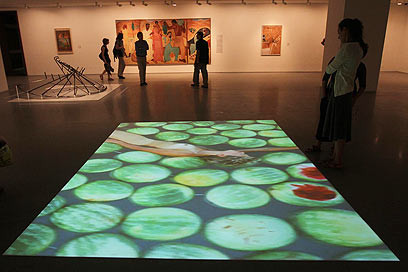
Israel Museum has new look at history of Holy Land
Fresh-faced after three-year, $100 million upgrade, Jerusalem museum offers unparalleled look into the development of monotheistic religions, while leaving plenty of room for both science and faith
The Israel Museum, fresh-faced after a three-year, $100 million upgrade, offers an unparalleled look into the development of monotheistic religions, while leaving plenty of room for both science and faith.
The museum's more devout visitors may feel vindicated by a collection of 3,000-year-old weapons used by ancient warriors in the Battle of Lachish, verifying the fighting as depicted in the Bible.

Visitors on opening night (Photo: Gil Yohanan)
The scientifically minded can point to a set of 1.5 million year old bull horns on display around the corner, by far predating Earth's creation as described by the book of Genesis.
One museum employee told how an ultra-Orthodox Jewish couple touring the museum was confused by the discrepancies.
"They asked why we dated the objects as being so old since according to the Bible, the world was created just 6,000 years ago," she said.
Bathhouse used by ancient King Herod
The museum's chief curator of archaeology, well aware of the precarious relationship between archaeology and religion, said some artefacts can be seen as confirmation of the Bible, but many findings don't match what was written.
"We present it as a play. From the oldest possible to the present," Michal Dayagi-Mendels said. "But what you can clearly see is the influence and inspiration things had on each other."
She referred to a new exhibit featuring the reconstruction of a church originally built about 400 years after the time of Jesus. It has daunting similarities to a synagogue of the same period reconstructed alongside.
The influence can also be seen in later Islamic relics on display nearby.

Ultra-Orthodox confused by discrepancies (Photo: Gil Yohanan)
Across the hall from Dayagi-Mendels' wing is a room from the modern art gallery – tripled in scale during the museum's overhaul – connecting the ancient Holy Land with the present.
The renewal, led by New York-based architect James Carpenter, modernized the 45-year-old hilltop campus and its older exhibits such as the Shrine of the Book, home of the ancient Dead Sea Scrolls. The museum, Israel's largest, doubled the size of its collection, said museum director James Snyder.
On exhibit for the first time is a portion of one of the few surviving crusader-era frescoes showing Jesus, John the Baptist and the Virgin Mary. The 12th century painting was found at the Abbey of the Virgin Mary in Jerusalem's Valley of Jehosaphat.
Visitors can also see a bathhouse used by the ancient King Herod, recently excavated from one of his desert palaces. It has been reconstructed with original pillars, tiles and a mosaic floor.
Information and pictures on the renewal of the museum and a guide to its galleries can be found here.
- Follow Ynetnews on Facebook










